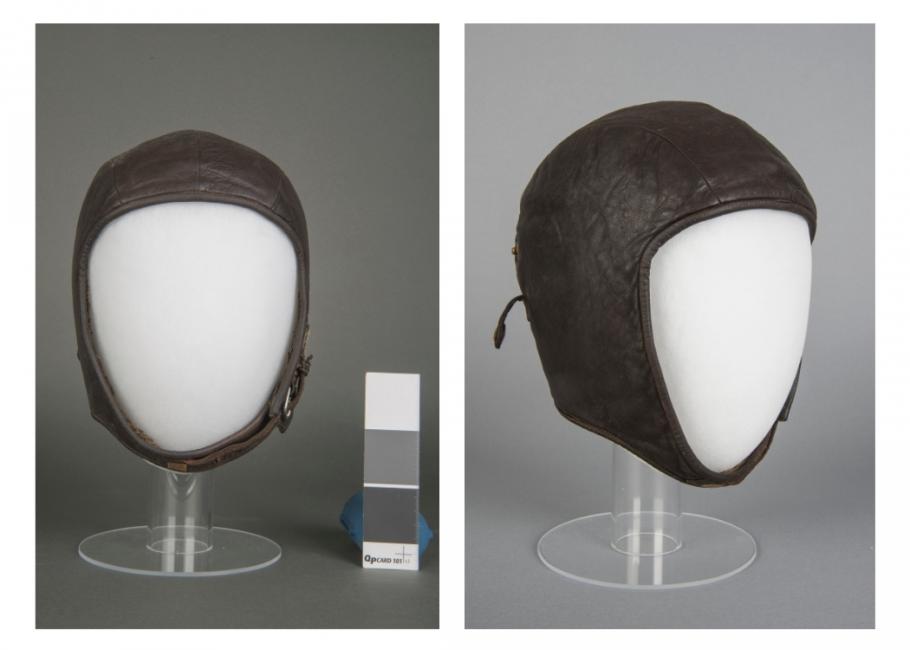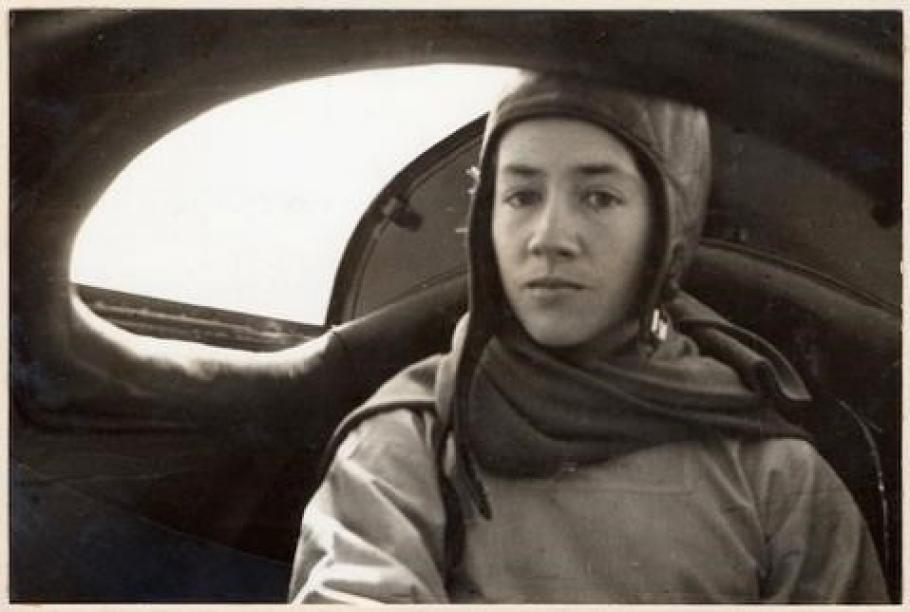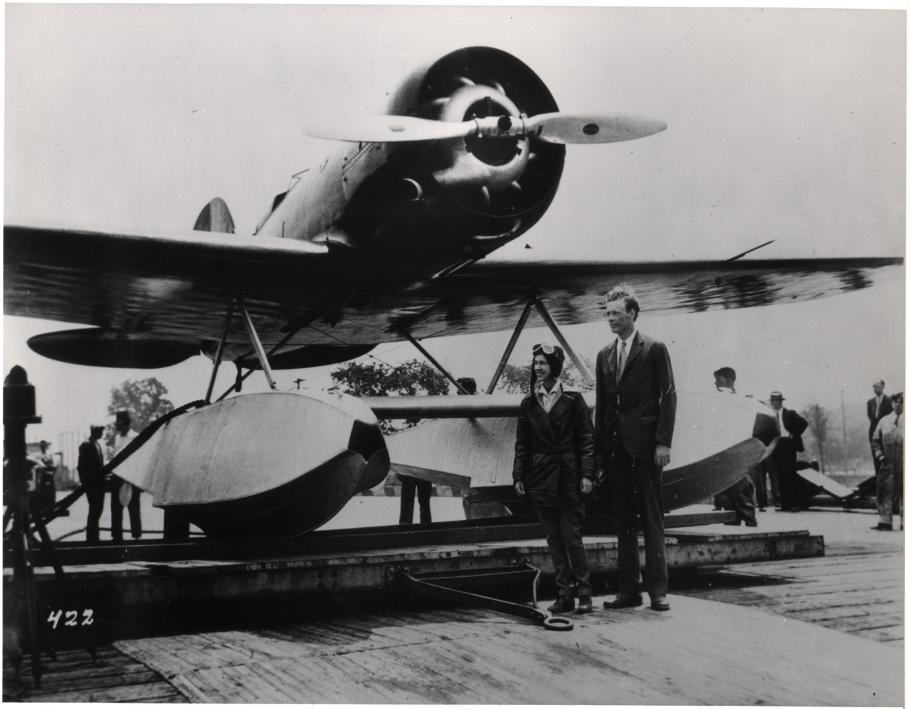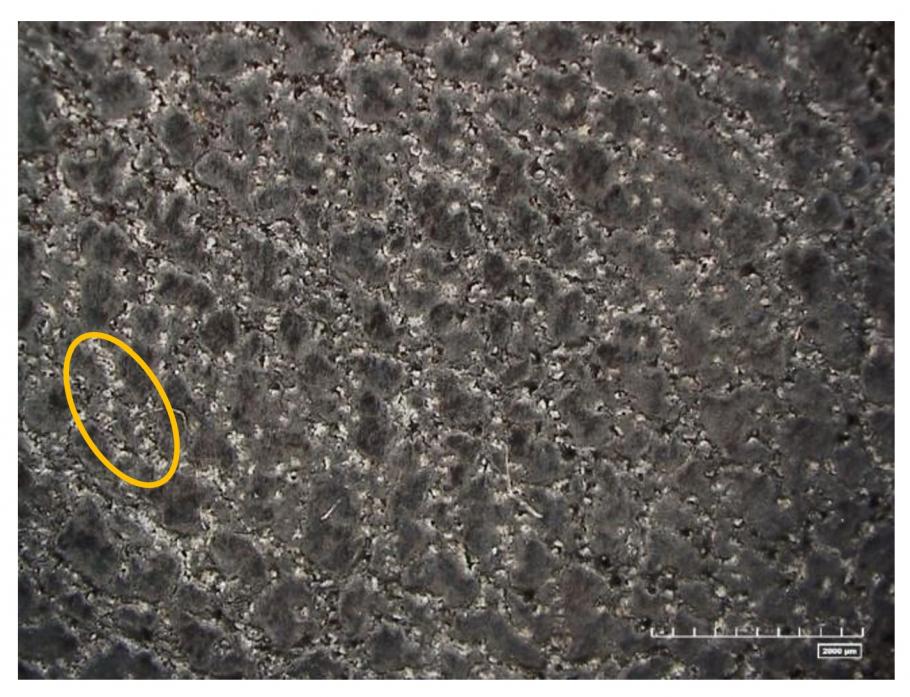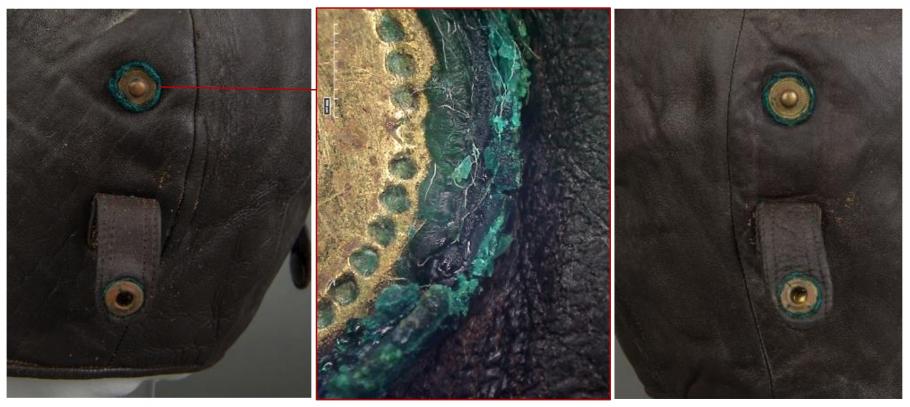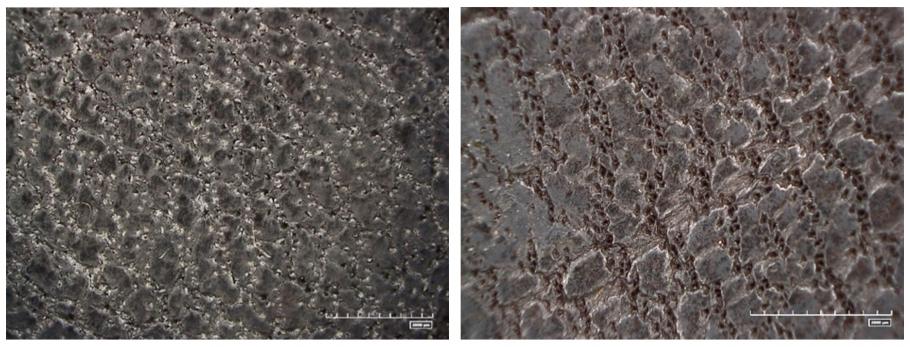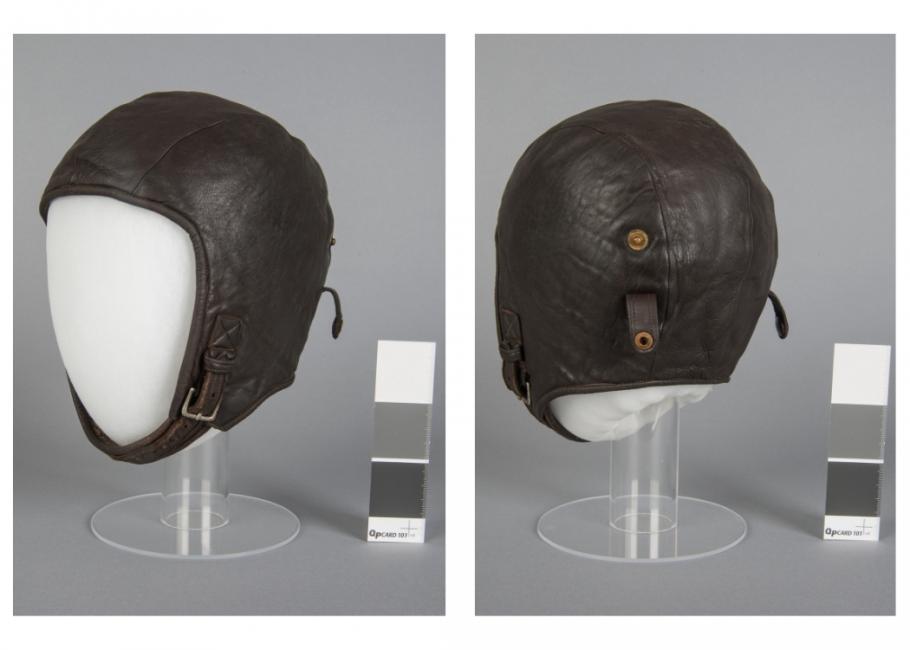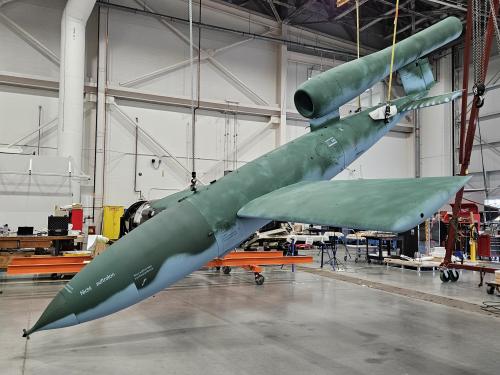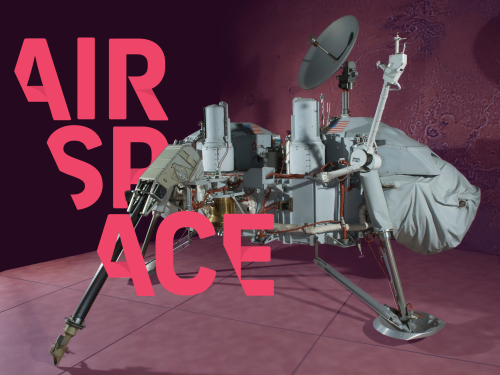
All Dressed Up: A Study of Stearate Growth Occurring on Anne Morrow Lindbergh’s Leather Flight Helmet
Dec 22, 2020
By Marci Jefcoat Burton
In 1931, Charles A. Lindbergh and his wife, Anne Morrow Lindbergh, flew in their Lockheed Model 8 Sirius Tingmissartoq aircraft to survey flight paths over northern Canada, Alaska, and the East Asia for Pan American Airways. Charles piloted the plane and Anne was his co-pilot and radio operator. In 1933 they flew the North Atlantic route through Greenland to Europe, then on to Moscow, down to Africa, over to South America, and back up to the United States, visiting 21 countries along the way.
Embarking on these flights in a small two-seater airplane required the Lindberghs to pack just the essential items, such as food, navigational equipment, and only the most necessary of personal items. One of Anne’s items was a simple brown leather flight helmet manufactured by A.G. Spaulding & Bros. (Figure 1). During the Tingmissartoq missions, she was photographed wearing it regularly while in the Sirius aircraft and when preparing for flights (Figures 2-3). The flight helmet provided Anne some warmth and a layer of protection during the northern latitude flights. Wherever Anne flew, the helmet was also there.
The Lindberghs donated the aircraft and personal items, including Anne’s leather helmet to the American Museum of Natural History in New York, after completion of the Tingmissartoq’s flight missions in late 1933. Then in 1955, the objects were donated to the U.S. Air Force Museum in Dayton, Ohio, before arriving at the Smithsonian, National Air and Space Museum in 1959.
The helmet was displayed at our Steven F. Udvar-Hazy Center beginning in 2003. In 2018, a peculiar condition phenomenon was observed on the helmet and it was removed from display for examination and conservation.
Helmet Construction
The Spaulding flight helmet is constructed from chromium-tanned, dark brown sheepskin-leather, lined with a taupe-colored faux fur (Figure 4). The back of the helmet has two leather straps with copper alloy fastener snaps that are meant to secure a pair of goggles. An adjustable leather chinstrap is secured with a ferrous alloy buckle. We see the typical evidence of wear on the leather from Anne repeatedly securing her helmet.
Figure 4: Interior of Anne Morrow Lindbergh’s leather flight helmet. The taupe faux fur completely lines the helmet interior to provide comfort and insulation.
Condition Issue Investigation
After removing it from display, three condition phenomena were observed:
- A waxy segmented exudate growth
- An overall white bloom
- A thick, waxy green corrosion product around fasteners
A waxy golden-brown exudate was observed in localized areas (Figures 5 and 6). Looking at the growth with digital microscopy, it measured up to 2-3 mm long and appeared to emerge through the pores/hair follicles of the leather grain and along the stitching. The waxy exudate also developed as a segmented structure (Figure 5(e)).
Figure 5: Waxy growth emerging from the grain of the leather. (a): Leather helmet, proper left side. (b): Detail of waxy segments in the chinstrap buckle region. (c): X-radiographic image of chinstrap buckle region. (d): Detail of waxy growth near the leather loop. (e): Photomicrograph details of waxy growth, showing a segmented structure.
Figure 6: Photomicrograph detail with waxy exudate emerging from and near the thread stitch holes on the underside of the PL goggle holder tab.
An opaque, white waxy bloom exudes from the leather, overall. The bloom is tacky and borders the follicle pores of the leather (Figure 7).
Figure 7: Detail of white bloom in follicles (Example indicated by yellow oval) of the leather, PL side of helmet. Photomicrograph collected with a HiROX digital microscope.
A thick accumulation of waxy green corrosion developed on the leather where it was in contact with the copper alloy goggle fasteners (Figure 8). This corrosion was likely caused by the interaction of fats in the leather (whether natural or from an applied dressing) and copper ions from the metal fasteners, commonly referred to as verdigris.[i]
Figure 8: Verdigris corrosion on goggle snap fasteners. (Left): Detail of corrosion on the proper left snap. (Middle): Photomicrograph of corrosion build up on the snap fastener stud. (Right): Detail of the proper right snap fastener with verdigris corrosion.
Identification of Waxy Exudates
A single segment of the waxy growth from the chinstrap loop was analyzed at the Smithsonian Museum Conservation Institute (MCI) with Attenuated total reflection-Fourier Transform Infrared (ATR-FTIR) spectroscopy. A match to stearic acid was confirmed when compared to a spectral database (Figure 9). Stearic acid is a white and waxy fatty acid found naturally in animal and plant fats and is also a primary component of leather dressings and lubricants.
Figure 9: ATR-FTIR spectra of a segment of waxy exudate (red spectrum) from the chinstrap loop on the PL side of the helmet matched with a reference spectrum of steric acid (green spectrum). Spectra courtesy of Thomas Lam, Smithsonian MCI. Spectrum collected with a Thermo Nicolet 6700 FTIR spectrometer with Golden Gate ATR.
Leather Dressings: Use and Preservation Problems
Leather dressings consist of oils, fats, waxes, or oil emulsions, and were applied to leathers to increase softness and flexibility.[ii] Most commercial stearic acid-based lubrication and softening products contain a mixture of 50% stearic acid, 45% palmitic acid, and 5% oleic acid. The fats, oils, and waxes in leather dressings tend to oxidize and become increasingly acidic, which can cause the leather to stiffen, darken, stain adjacent materials, become tacky and attract insects and pests.[iii] Over time, the waxy components also tend to separate and migrate through the pores of the leather grain, depositing exudate on the surface as a bloom.
Common dressings that were used to treat leather include 1) Vaseline, 2) neatsfoot oil and lanolin, 3) oil and tallow emulsions, and 4) a mixture of lanolin, wax, castor oil, sodium stearate, and water.[iv] There were also a wide variety of proprietary leather dressings on the market with unknown ingredients.
The identification of stearic acid on Anne’s helmet supports the assumption that it was given a previous application of leather dressing. Leather components that require more flexibility for use, such as the chinstrap buckle and the goggle holder straps, likely received a heavier application and multiple campaigns of dressing to remain functional. The question of whether a dressing was applied during use by Anne Morrow Lindbergh, or by an institution during its collection history, is unknown.
Conservation Treatment
The stearate exudate growth, overall white bloom, and waxy green copper corrosion on the helmet detract from the visual aesthetics. The helmet was previously treated with a stearate-based leather dressing to soften the leather. The darkening side effect hides minor authentic scratches and wear—the evidence of use that developed when it was worn by Anne. With all this in mind, it was decided to remove the superficial layer of dressing from the surface, and in doing so, also remove the stearate growth, bloom, and verdigris. This would allow the helmet to return to an appearance closer to its original condition and aesthetic when the Lindberghs donated the helmet after the Tingmissartoq flight missions.
All stearic acid exudate segments were removed by lightly wiping the waxy exudate segments with a bamboo skewer. This effectively knocked off the growth, as the segments were loosely bound to the leather surface.
The bulk of the verdigris corrosion was removed from the leather and goggle holder snaps with a bamboo skewer, followed by cotton swabs, and low polarity organic solvents to remove the waxy residue.
Removal of the sticky white bloom from the leather grain was first tested with a dry cotton swab, which yielded no change in the bloom removal since the bloom was recessed from the surface. Swabs with mineral spirits, Stoddard’s solvent, and ethanol were each tested in a small area to determine the efficacy of each solvent for bloom removal. The tested areas dried overnight and the test locations were monitored for any change to the leather surface. All three effectively removed the bloom, however, mineral spirits and Stoddard’s solvent each worked quickest and required the least swab rolling on the leather surface.
After solubility testing, the white bloom was removed under magnification from the leather with cotton swabs and mineral spirits. Stoddard solvent was used to remove the more tenacious areas of bloom. The discarded cotton swabs were the same dark yellow-brown color as the base of the stearic acid exudate (Figure 10). Analysis of the used swabs with ATR-FTIR confirmed the white bloom on the helmet was also stearic acid. This also confirmed that the treatment only removed the stearate compound originating from the dressing and nothing else from the helmet (Figure 10(d)).
Figure 10: (a): Photomicrograph detail of stearic acid exudate. (b): Cotton swab with bloom. (c): During treatment image after cleaning with mineral spirits (cleaned area indicated with red box). (d): ATR-FTIR spectral comparison: cotton swab with bloom (blue spectrum), clean, unused cotton swab (red spectrum) and stearic acid exudate collected from the PL goggle holder tab (green spectrum). Significant peaks match between the residue and the exudate are indicated in black boxes. Peaks that do not match with the exudate match with a clean cotton swab. Spectra collected with a 4100 ExoScan FTIR (handheld) Spherical Diamond ATR head.
The Helmet After Treatment
The waxy stearic acid exudate was easily removed mechanically, as the segments were more loosely adhered to the leather surface than the white bloom. This white bloom and smaller segments of stearic acid growth were more tenaciously bound to the leather and were removed with organic solvents. Solvent cleaning effectively solubilized and removed the surface layer of the leather dressing, which will inform any future treatments if the stearic acid growths and bloom ever redevelop. The success of the bloom removal from the follicle pores was confirmed with microscopy (Figure 11).
Figure 11: (Left): Before treatment, detail of white bloom exuding from the hair follicles of the leather grain. (Right): After treatment, detail of leather grain after solvent cleaning, showing removal of the white bloom from hair follicles. Photomicrographs collected from the PL side of the helmet with the HiROX digital microscope.
The dressing reduction on the surface uncovered areas of light-brown surface abrasion likely acquired from use by Anne Morrow Lindbergh. These areas of wear serve as historical attributes of the helmet’s use during Tingmissartoq’s 30,000 miles of flight. The exposure of the surface damages reveals an original patina and returns the helmet to its natural aesthetics (Figure 12).
Figure 12: Anne Morrow Lindbergh Flight Helmet, After Treatment. (Left): Front, proper left side. (Right): Back of helmet.
Going Forward
These condition issues developed slowly while on display and in a controlled museum environment. While the stearic acid growth and copper alloy corrosion were removed, these condition issues will likely re-develop over time. The previously applied dressing has saturated the leather and there is currently no acceptable treatment protocol in place for its complete removal. The fatty acids in the dressing will continue to interact with the embedded copper alloy snaps to produce more waxy green corrosion, as well as continue to migrate from the follicles and pores of the leather as a bloom and exudate. Therefore, the helmet will be periodically monitored in the display case for the return of these growths when this established treatment methodology can be employed again.
The author would like to thank Thomas Lam at the Smithsonian, Museum Conservation Institute for the ATR-FTIR analysis and spectra, helping in identification of the stearic acid compound.
All images were collected by the author unless otherwise specified.
All photomicrographs were collected with a HiROX digital microscope.
Marci Jefcoat Burton served as an Engen Conservation Fellow at the Smithsonian's National Air and Space Museum in 2018.
[i] Canadian Conservation Institute. 2017. “Products Used in Preventive Conservation”, CCI Technical Bulletin, No. 32; Scott, D. 2002. Copper and Bronze in Art: Corrosion, Colorants, Conservation. Los Angeles: Getty Publications.
[ii] Canadian Conservation Institute. 1992. “Care of Alum, Vegetable and Mineral Tanned Leather”,
CCI Notes, Vol. 8, Issue 2, Ottawa: Canadian Conservation Institute, pp. 1-4.
[iii] Raphael, T. 1993. “Leather Dressing: To Dress or Not To Dress”, Conserv O Gram, No. 9, Issue
1. National Park Service, July 1993; Canadian Conservation Institute. 1992.
[iv] Raphael, T. 1993.
Related Topics
You may also like
We rely on the generous support of donors, sponsors, members, and other benefactors to share the history and impact of aviation and spaceflight, educate the public, and inspire future generations. With your help, we can continue to preserve and safeguard the world’s most comprehensive collection of artifacts representing the great achievements of flight and space exploration.
